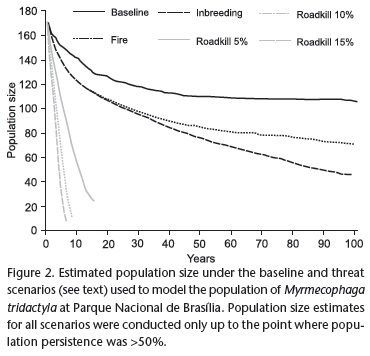Urbanization poses a serious threat to wildlife populations inhabiting native vegetation remnants surrounded by the expanding urban and suburban sprawl. The close contact with human activities causes not only direct impacts, such as habitat loss, but also indirect negative effects, such as population isolation, roadkills and anthropogenic fires. The Parque Nacional de Brasília is a large Cerrado remnant almost completely surrounded by the city of Brasília, in central Brazil. Here, we use population viability analysis to model the impacts of urbanization on a population of Myrmecophaga tridactyla (Linnaeus, 1758) inhabiting that park. Our results show that roadkill mortality is by far the most serious threat to the long-term persistence of the giant anteater in the study site. The implementation of measures to better control vehicle speed in the vicinity of the park is urgently needed if we expect the giant anteater population to be effectively protected in the Parque Nacional de Brasília.
Extinction; inbreeding; PVA; roadkill; wildfire




